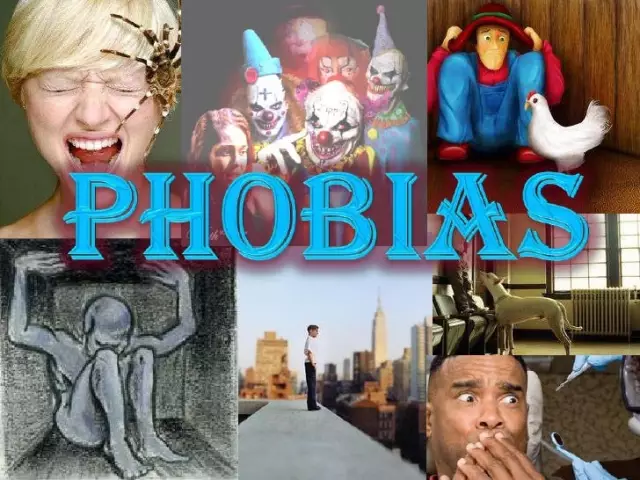- Author Rachel Wainwright [email protected].
- Public 2023-12-15 07:39.
- Last modified 2025-11-02 20:14.
Phobias: causes and types, how to deal with them

Literally translated "phobia" means fear. Currently, this term denotes a specific type of fear - an irrational, not explainable by objective reasons, constantly acting fear in relation to any object, action or situation.
Phobias usually appear in childhood, and can accompany a person all his life, but most often, sooner or later, people find an opportunity to cope with their phobias, and, according to experts, about 90% of those who suffer from this type of nervous disorder, sooner or later do it yourself. The remaining 10% of people prone to phobias either arrange their lives in such a way as to minimize traumatic factors, subordinating their lives to the problem, or they turn to specialists.
Causes of phobias
All phobias can be divided into two groups: the first is one where the cause is a traumatic situation experienced in childhood, and which left an imprint on the psyche, allowing fear to spread to all those types of situations that are similar to the one experienced once. For example, if the baby was once very frightened by a spider crawling on the leg, arachnophobia may develop - the fear of any spiders, if the stress associated with strong noise has been experienced, then brontophobia - fear of thunder, and so on - may become the result.
The second group of phobias are fears, the reasons for which cannot be found out. So, if it is precisely known that there was never any horror experienced at the sight of a spider, since there were no meetings with spiders, the roots of arachnophobia are unclear. In this case, the compensatory reactions of the psyche should be taken into account - the child in most cases forgets what caused the severe mental trauma. Therefore, sometimes, if a person says that nothing of the kind happened, he may simply not remember about it, since protective mental mechanisms have worked. However, there are truly unexplained phobias and they are quite numerous.
Why do some people have irrational fears, while others, even after the horror they have experienced, do not? Here the point is in the individual characteristics of the psyche. As a rule, people who are sensitive, impressionable and vulnerable, with a rich inner world, prone to increased anxiety and excessive mental reactions are prone to phobias. Again, this is not a requirement. Phobia can also manifest itself in a person with a strong psyche, not prone to reflection. Psychotherapists suggest that heredity plays an important role in the mechanism of formation of irrational fear. People whose relatives are prone to phobias suffer from them much more often than others.
It is impossible not to mention the entertaining, but reliably unconfirmed point of view of esotericists - they argue that the roots of phobias cannot always be found for the reason that people bring some of them with them from past lives. Such a branch of psychology as regressive hypnosis, in particular, is trying to try to understand this theory.
Types of phobias
There are extremely many types of phobias, so much so that it makes no sense to list them - in fact, any object, any living creature and any situation under certain circumstances can become traumatic, and subsequently their reproduction will cause fear. Therefore, for convenience, psychologists divide phobias either into the most common and the rest, or divide them into groups according to the traumatic sign.

The most common phobias are:
- Sociophobia is a fear of society, it can manifest itself in various forms, such as avoiding or minimizing any social contacts or fear of public speaking;
- Acrophobia is a fear of heights. This phobia is so common that it is sometimes considered not so much a deviation as a defense mechanism. However, when she interferes in a person's life, for example, if a person experiences fear looking down from the balcony of a high-rise building, and therefore avoids being on any floor higher than the second, this is precisely a phobia;
- Nobody phobia is fear of the dark. Another common type of irrational fear that everyone seems to have suffered from in childhood, with rare exceptions;
- Kinophobia is a fear of dogs. Sometimes it is an understandable fear if a person has ever been attacked by a dog, but more often people who are prone to kinophobia feel terrified at the sight of dogs, having never before had contact with them;
- Claustrophobia - fear of confined spaces
- Agoraphobia is the opposite of claustrophobia, a fear of open spaces. In this case, a person acutely feels his own defenselessness, getting into a large open space and not being able to hide.
Common ones also include fear of spiders (arachnophobia), snakes (herpetophobia), blood (hemophobia), and, oddly enough, fear of clowns (coulrophobia).
For convenience, all phobias are grouped into groups:
- Situational phobias;
- Phobias of animals;
- Phobias caused by natural phenomena;
- Others - this group includes phobias, which are very difficult to classify, for example, phobophobia - the fear of phobias.
Phobias
Phobias manifest themselves in the same way as any other attack of intense fear, with one exception - the agent who caused this fear poses no threat. In addition to the feeling of panic, an attack of phobia is accompanied by reactions from the autonomic nervous system. A person can be thrown into heat or cold, cold sweat appears, heart rate increases, weakness in the limbs appears, trembling, tinnitus, often a person cannot utter a word because the throat constricts a spasm. There may be a reaction from the digestive tract in the form of nausea, and sometimes even vomiting or diarrhea.
How to deal with phobias
If a phobia interferes with life and worsens its quality, and this usually happens, then it is imperative to fight it, since with the right approach there is every chance to get rid of this fear once and for all. You can try to do it yourself, or contact a psychotherapist. What cannot be done categorically is to deal with phobias of other people by immersing them in a traumatic situation. This is extremely dangerous, as it can cause irreparable damage to the human psyche. Therefore, you can fight on your own only with your own phobias - the psyche will tell the person when he should slow down so as not to harm.
The first step in therapy is to acknowledge the existence of the problem, which many people have avoided for many years because they feel ashamed. In the future, the essence of the treatment is to carefully approach your fear, gradually realizing that it is irrational, and in fact, meeting with it does not pose any threat.
Psychotherapists fight phobias with cognitive behavioral therapy (CBT), in severe cases, resorting to medication. The goal of CBT is to change the way of thinking, to eliminate the root of the phobia - to correct that deep mental tuning that led to the emergence of fear, to teach a person to manage their behavior, completely taking control of their reactions.
With the right complex action, all phobias without exception are curable.
Found a mistake in the text? Select it and press Ctrl + Enter.






